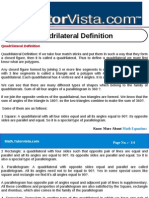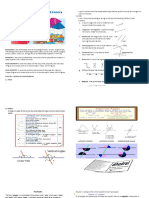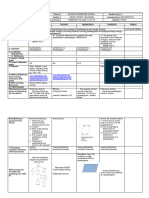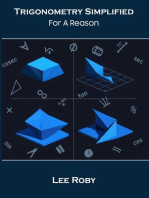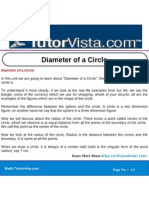What Is A Parallelogram
Uploaded by
api-140032165What Is A Parallelogram
Uploaded by
api-140032165What is a Parallelogram
What is a Parallelogram A closed figure formed by joining 3 or more line segments are called polygons and the sides of the polygons do not cross each other. Different polygons are named based on the number of sided in its figure: If we have a closed figure formed by joining 3 line segments it is called a triangle. Similarly a figure formed by joining 4 line segments is called a quadrilateral. A figure formed by joining 5 line segments is called a pentagon. Figure formed by joining 6 line segments is called a hexagon, a seven sided figure is heptagon, an eight sided figure is octagon, a nine sided figure is nonagon, and a ten sided figure is called decagon. If a polygon has all the sides equal then it is called a regular polygon. Parallelogram Definition: A quadrilateral is a shape formed by joining 4 line segments. Different types of quadrilaterals can be formed. As opposite sides of a parallelogram are parallel so they will never meet or intersect. Opposite sides of a parallelogram are congruent and the diagonals of a parallelogram always bisect each other. Know More About Math Help For Free
Math.Tutorvista.com
Page No. :- 1/4
A parallelogram is a special type of quadrilateral, in which its opposite sides are equal and parallel. We can see Many special figures which come in the family of parallelograms. They are as follows : 1. Square: A figure in which all the four sides are equal and all the four angles are 90? is called a square. We observe that a square is a special kind of parallelogram in which * All sides are equal * Its diagonals are perpendicular bisectors of each other and * All angles are 90?. We find that opposite sides of a square are parallel and equal , so it is also called parallelogram. Also as its all sides are equal, so it is also called a regular quadrilateral. 2. Rectangle: A figure with opposite sides equal and all its angles are 90 ? is called a rectangle. This figure is also a special kind of parallelogram in which * All angles are 90 ? * Its Diagonal bisect each other and * Opposite sides are equal and parallel. So it is also called Parallelogram. It is called a special parallelogram which has all its angles equal to 90?. 3. Rhombus : A figure with all four sides equal and its diagonals bisect each other at 90? is called a rhombus. This figure when tilted in such a way that all its angles becomes 90?, then it takes the shape of a square. It is another kind of a parallelogram as its opposite sides are parallel and equal. Some properties of a Parallelogram i.e. the property of Parallelogram are true and which is having the descendant shapes. There are many more terms which define the properties of parallelogram, which are: Learn More Calculus Tutorial Math.Tutorvista.com
Page No. :- 2/4
Base any side in the parallelogram can be considered as base of a parallelogram. We can choose any one as we like. It is also used to calculate the area of a Parallelogram. It is also used corresponding altitude. Altitude the meaning of altitude is height. And it is a perpendicular distance from the base to the opposite side which can be extended. Area the area of a parallelogram is the perpendicular distance from the base to the opposite side. Perimeter perimeter is the distance around the parallelogram. Opposite sides opposite sides of a parallelogram are congruent or we can say which is equal in length. As we reshape the parallelogram than also the opposite sides of a parallelogram are always the same length. Diagonals each diagonal of a parallelogram cut the other diagonal into two equal parts. Interior angles opposite angles of a parallelogram are always equal. And consecutive angles of a parallelogram are always tends to 180 degree. Or we can say that it is always supplementary. There are many different types of a parallelogram are: Square, Rhomboid, Rectangle
A square is both a rectangle and a rhombus and its satisfy all of its properties. Every diagonals of a rhombus bisects two angles of the rhombus. The diagonals of a rhombus are perpendicular. Example: - Find the area of a parallelogram with a base of 25 centimeters and a height of 15 centimeters. Solution:- we know that the area of a parallelogram = b. h A = b. h Putting the value of base and height in the given formula,
Math.Tutorvista.com
Page No. :- 4/4
ThankYou
Math.TutorVista.com
You might also like
- Instructor: Ruhiyya Gafarli Level Grade: 10 Topic Name: ParallelogramNo ratings yetInstructor: Ruhiyya Gafarli Level Grade: 10 Topic Name: Parallelogram5 pages
- A Closer Look at The Properties of Parallelograms and Special ParallelogramsNo ratings yetA Closer Look at The Properties of Parallelograms and Special Parallelograms3 pages
- MATH9 Q3 2 WK1 Properties of ParallelogramsNo ratings yetMATH9 Q3 2 WK1 Properties of Parallelograms22 pages
- Quadrilaterals: BP's Academy (Call Us: 9422031727 / 9096989707)No ratings yetQuadrilaterals: BP's Academy (Call Us: 9422031727 / 9096989707)2 pages
- Parallelograms: Rhomboid Right Angles Rectangle Rhombus SquareNo ratings yetParallelograms: Rhomboid Right Angles Rectangle Rhombus Square2 pages
- (Quadrilaterals) & (Circles) - Study ModuleNo ratings yet(Quadrilaterals) & (Circles) - Study Module131 pages
- Q3 W2 Lesson 2 Properties of ParallelogramNo ratings yetQ3 W2 Lesson 2 Properties of Parallelogram38 pages
- Innovation - SIM - Properties of Parallelogram - BookletNo ratings yetInnovation - SIM - Properties of Parallelogram - Booklet10 pages
- Instructor: Ruhiyya Gafarli Level Grade: 10 Topic Name: ParallelogramInstructor: Ruhiyya Gafarli Level Grade: 10 Topic Name: Parallelogram
- A Closer Look at The Properties of Parallelograms and Special ParallelogramsA Closer Look at The Properties of Parallelograms and Special Parallelograms
- Quadrilaterals: BP's Academy (Call Us: 9422031727 / 9096989707)Quadrilaterals: BP's Academy (Call Us: 9422031727 / 9096989707)
- Parallelograms: Rhomboid Right Angles Rectangle Rhombus SquareParallelograms: Rhomboid Right Angles Rectangle Rhombus Square
- Innovation - SIM - Properties of Parallelogram - BookletInnovation - SIM - Properties of Parallelogram - Booklet

